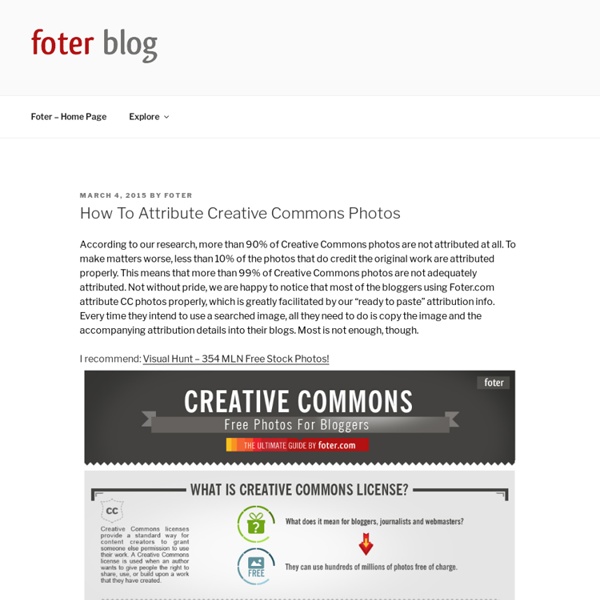Creative Commons Starts with Making – A Reflection on Creating and Sharing – Read Write Respond
flickr photo shared by mrkrndvs under a Creative Commons ( BY-SA ) license I was reminded again this week about the importance of Creative Commons. Firstly, my students got a bit stuck getting their heads around what was right for use while creating presentations, while secondly, Mark Anderson wrote a post sharing why he worries about teachers blogging. Beyond the initial frustration about the lack of foresight in regards to the wider audience and subsequent poor judgement, Anderson discusses his concern over the use and reference to content. From copying someone else’s image to sharing student images, he provides three suggestions: Use CC Search if you are trying to find appropriate contentReference ideas and content when you are borrowingAlways err on the side of caution when sharing student content online
Masters of Photography with their most famous images - AGONISTICA
Tim Mantoani has shot over 150 portraits of Famous Photographers with their iconic images in the book Behind Photographs: Archiving Photographic Legends. Photo Above: Steve Mcurry with ‘Afgan Girl’. Steve McCurry holds his 1984 photo of a young woman from Peshawar, Pakistan.
The Metropolitan Museum of Art Puts 400,000 High-Res Images Online & Makes Them Free to Use - Open Culture
On Friday, The Metropolitan Museum of Art announced that "more than 400,000 high-resolution digital images of public domain works in the Museum’s world-renowned collection may be downloaded directly from the Museum’s website for non-commercial use." Even better, the images can be used at no charge (and without getting permission from the museum). In making this announcement, the Met joined other world-class museums in putting put large troves of digital art online. Witness the 87,000 images from the Getty in L.A., the 125,000 Dutch masterpieces from the Rijksmuseum, the 35,000 artistic images from the National Gallery, and the 57,000 works of art on Google Art Project.
Explainer: Creative Commons
The digital age has presented many and diverse challenges for copyright law. The rapid uptake of digital, networked technologies led to widespread online distribution of content, as well as the emergence of new practices and technologies that enabled digital content to be shared, reused and remixed on an unprecedented scale. But while technology provided the capacity for sharing and reuse of content to occur on a vast scale, legal restrictions on the use of copyright material hampered its negotiability in the digital environment.
30+ Crazy Photographers Who Will Do ANYTHING For The Perfect Shot
Getting the angle and perspective for a photo just right can sometimes be very tricky, but these crazy photographers don't mind – when it comes to taking the perfect shot, they will do whatever it takes. The acts of devotion to their craft that some of the world's best photographers perform can be truly outstanding. Wildlife photographers have spent weeks camped out in the wild, allowing animals to get accustomed to their presence so that they can get the rare or intimate glimpses at their lives that others only dream of. Show 34 more Add Image
5 Tools for Helping Students Find Creative Commons Images
Overview Photos, logos, graphics and images are an important part of any multimedia creation that students produce. A few well placed, high quality images can transform class work from amateur to spectacularly professional.
Ethical Blogging: Sourcing Images
Another Wednesday, another post on ethical blogging! For those who are just coming to Future Conscience, I have recently started a series of posts on what we feel are some good blogging practices. Each week we will be looking at a different topic in order to try and build up a body of information for bloggers new and old alike that helps guide you towards a more ethical mindset when it comes to your blog. It’s not hard to find fantastic, ethical images for your blog Today I’m going to take a look at a very important aspect of blog posts: images.
Eight Norwegian Photographers You Need to Follow
The Norwegian Journal of Photography (NJP) has released the latest issue of its biennial survey of the Scandinavian country’s contemporary documentary photography scene, showcasing the work of eight photographers. The publishers — photographers and photo editors Rune Eraker, Laara Matsen and Espen Rasmussen — combed through close to 100 applications and submissions to arrive at its final list of eight photographers, using funding from the Fritt Ord Foundation, a non-profit devoted to freedom of expression, to produce the high-quality book. “We look for strong voices,” Espen tells TIME, “and we also look for photographers who challenge the term ‘documentary photography’. Do they have a style, something to tell us, do they surprise us or challenge us? Do they create any feelings for us as a viewer? Once chosen, the NJP works with these photographers to craft and edit their long term projects, and to find financial support.
Copyright Subject Guide - RMIT LibGuides - Mobile
Can you include images, figures, diagrams, photographs, journal articles & conference papers into your thesis - YES. The copyright act has fair dealing provisions that allow students to include copyright works into theses for research & study purposes that includes research and examination. Do you need permission to include copyright works into your thesis for examination – NO. You need permission to use copyright works in your thesis if it is published or used outside of research and study purposes.


